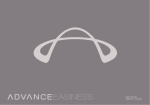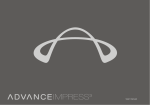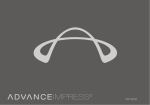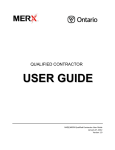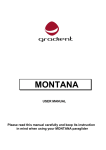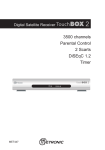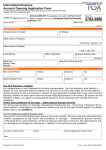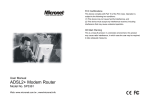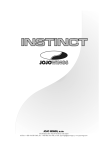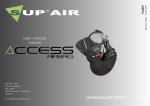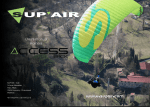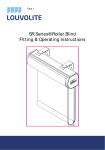Download User manual
Transcript
Manual Edition 1 / 04_2014 Edition 1 / 04_2014 Contents Thank you for flying ADVANCE. . . . . . . . . . . . . . . . . . . . . . . . . . . . . . 6 About ADVANCE. . . . . . . . . . . . . . . . . . . . . . . . . . . . . . . . . . . . . . . . 7 The PROGRESS 2. . . . . . . . . . . . . . . . . . . . . . . . . . . . . . . . . . . . . . . 8 Welcome on board! . . . . . . . . . . . . . . . . . . . . . . . . . . . . . 8 Outstanding PROGRESS 2 features . . . . . . . . . . . . . . . . 8 More important details. . . . . . . . . . . . . . . . . . . . . . . . . . . 9 Safety advice. . . . . . . . . . . . . . . . . . . . . . . . . . . . . . . . . . . . . . . . . . 10 General advice about paragliding . . . . . . . . . . . . . . . . . 10 Preparing the product. . . . . . . . . . . . . . . . . . . . . . . . . . . . . . . . . . . 11 Delivery . . . . . . . . . . . . . . . . . . . . . . . . . . . . . . . . . . . . . 11 Delivery package. . . . . . . . . . . . . . . . . . . . . . . . . . . . . . 11 Airbag . . . . . . . . . . . . . . . . . . . . . . . . . . . . . . . . . . . . . . 11 Harness adjustment. . . . . . . . . . . . . . . . . . . . . . . . . . . . 12 Installing the reserve . . . . . . . . . . . . . . . . . . . . . . . . . . . 17 Setting up the Rucksack Mode . . . . . . . . . . . . . . . . . . . 26 Use in practice. . . . . . . . . . . . . . . . . . . . . . . . . . . . . . . . 26 Reversing technique . . . . . . . . . . . . . . . . . . . . . . . . . . . 27 Flying. . . . . . . . . . . . . . . . . . . . . . . . . . . . . . . . . . . . . . . . . . . . . . . . 30 General . . . . . . . . . . . . . . . . . . . . . . . . . . . . . . . . . . . . . 30 Ground handling . . . . . . . . . . . . . . . . . . . . . . . . . . . . . . 30 Takeoff and landing . . . . . . . . . . . . . . . . . . . . . . . . . . . . 30 Using the speed system. . . . . . . . . . . . . . . . . . . . . . . . . 31 Flying with a foot stirrup. . . . . . . . . . . . . . . . . . . . . . . . . 31 Flying with ballast. . . . . . . . . . . . . . . . . . . . . . . . . . . . . . 31 Use for teaching. . . . . . . . . . . . . . . . . . . . . . . . . . . . . . . 31 Use with gliders of other manufacturers. . . . . . . . . . . . . 32 Winching . . . . . . . . . . . . . . . . . . . . . . . . . . . . . . . . . . . . 32 Acro flying . . . . . . . . . . . . . . . . . . . . . . . . . . . . . . . . . . . 32 Tandem flying. . . . . . . . . . . . . . . . . . . . . . . . . . . . . . . . . 32 Takeoff preparation. . . . . . . . . . . . . . . . . . . . . . . . . . . . .32 Care, repairs and checks. . . . . . . . . . . . . . . . . . . . . . . . . . . . . . . . . 34 Care. . . . . . . . . . . . . . . . . . . . . . . . . . . . . . . . . . . . . . . . 34 Airbag care. . . . . . . . . . . . . . . . . . . . . . . . . . . . . . . . . . . 35 Check . . . . . . . . . . . . . . . . . . . . . . . . . . . . . . . . . . . . . . 35 3 Repairs. . . . . . . . . . . . . . . . . . . . . . . . . . . . . . . . . . . . . . 36 Disposal. . . . . . . . . . . . . . . . . . . . . . . . . . . . . . . . . . . . . 36 Technical details. . . . . . . . . . . . . . . . . . . . . . . . . . . . . . . . . . . . . . . . Technical details. . . . . . . . . . . . . . . . . . . . . . . . . . . . . . . 37 Materials used. . . . . . . . . . . . . . . . . . . . . . . . . . . . . . . . 38 Certification. . . . . . . . . . . . . . . . . . . . . . . . . . . . . . . . . . 38 Service . . . . . . . . . . . . . . . . . . . . . . . . . . . . . . . . . . . . . . . . . . . . . . ADVANCE website. . . . . . . . . . . . . . . . . . . . . . . . . . . . . 39 Warranty . . . . . . . . . . . . . . . . . . . . . . . . . . . . . . . . . . . . 40 Parts Harness. . . . . . . . . . . . . . . . . . . . . . . . . . . . . . . . . . . . . . . . . Front view . . . . . . . . . . . . . . . . . . . . . . . . . . . . . . . . . . . 42 Side view. . . . . . . . . . . . . . . . . . . . . . . . . . . . . . . . . . . . 43 Rucksack. . . . . . . . . . . . . . . . . . . . . . . . . . . . . . . . . . . . . . . . . . . . . Side view. . . . . . . . . . . . . . . . . . . . . . . . . . . . . . . . . . . . 44 4 37 39 42 44 5 Thank you for flying ADVANCE Congratulations and many thanks for choosing a PROGRESS 2, an ADVANCE quality product. We hope that it will bring you many rewarding hours in the air. This owner’s handbook is an important component of this flying equipment. In it you will find instructions and important advice about safety, care and maintenance; so we suggest that you read it carefully before your first flight with this product. The latest version of this handbook and updated information can be found on www.advance.ch. Any new safety-related advice about the product will also be published there. If you have a query or problem please go to the retailer, or contact ADVANCE directly. Now we wish you a lot of pleasure with your PROGRESS 2 and «happy landings»; every time. Team ADVANCE 6 About ADVANCE ADVANCE is one of the worldwide leading paraglider manufacturers, based in Switzerland. Since its founding in 1988 the company has always followed its own ideas and concepts, in both development and production. The results are well-finished products with distinctive character and qualities. Behind the brand is a team of specialists who share a passion for, and confidence in the ADVANCE products they create. At home in the air themselves, they bring valuable personal experience and commitment to the working processes. Comprehensive supervision of the production process and control of working practices at ADVANCE’s own factory in Vietnam guarantees a high quality of workmanship. A many-year relationship with cloth and line manufacturers ensures that ADVANCE knowhow flows directly into the development of new materials. ADVANCE put great value on after-sales customer care, and a worldwide service network has been built up to this end. New knowledge is constantly gained by an on-going exchange of experience with customers, which finds its way into new ADVANCE products – thus completing the «Circle of Service». 7 The PROGRESS 2 Welcome on board! Outstanding PROGRESS 2 features The PROGRESS 2 is a very light and comfortable reversible harness with a built-in reserve system and an airbag protector. The no-seatboard inside-out harness weighs 3.5 kg (M size); unique for its type! Unique also because (at present!) the PROGRESS 2 is the only reversible harness on the market with integrated reserve and top scoring protection. Its perfectly positioned carabiners give the PROGRESS 2 a comfortable and quiet feeling in flight – conveying safety. This harness is best suitable for classic recreational pilots, Hikers & Flyers and travellers. As a rucksack it has a volume of 75 Ltr. §§ Seat surface that conforms perfectly to body shape 8 §§ Exceptional standing, takeoff and handling comfort because there is no seatboard, and the reserve is on the back §§ Easy to slide in and out in flight §§ Air-filled back compartment for added protection §§ Streamlined elegant look §§ Top protector scores §§ Generous and reassuring protector volume; the protector does not compete with the reserve for space. More important details Rucksack mode Harness mode §§ Removable waist strap §§ The harness has the reliable and familiar two-buckle combined chest and leg strap system (called Safe-T-System ). §§ Various attachment features and pockets on the rucksack §§ Adjustable sized, stowable helmet net §§ Failure-resistant 15 mm strap system with “easy adjust” buckles §§ Closable pocket on the waist strap §§ Adjustable sitting angle §§ Bungee chord on the back for holding clothing §§ Reserve shoulder suspension §§ Drink tube holders on the shoulder straps §§ Drink tube openings and holding loops on the shoulder straps §§ Ergonomically shaped back support and shoulder straps §§ Ball bearing pulleys for the speed system – comfortable to use §§ Hand loops on the shoulder straps for relaxed hiking §§ Rucksack compression system §§ Stowable hiking stick and ice axe holders §§ ADVANCE Look: classy, clear and simple 9 Safety advice Like all commercially available reserves paraglider harnesses are not at all suitable for freefall use because of their design features. The reserve parachute and its connections to the harness are not constructed for an abrupt opening. All adjustments to the harness should be carried out before flight. Correct set-up of the harness plays an important part in ensuring satisfactory function, safety and comfort in flight. The PROGRESS 2 is exclusively to be used for paraglider flying. General advice about paragliding To take part in the sport of paragliding appropriate training and well-founded knowledge of the equipment are needed, as are the necessary insurance and licensing. A pilot has to be able to correctly assess the weather conditions before flight. His abilities must be good enough to manage the demands of the paraglider that is to be used. When carrying out paragliding the pilot must also take responsibility for his care of the natural world and the landscape. Other essential items include the wearing of an adequate helmet, suitable shoes and clothing, and the carriage of an emergency parachute (reserve). Equipment must be checked for damage and its airworthiness confirmed before every flight. A pre-takeoff check must always be carried out. 10 Every pilot bears exclusive responsibility for all risk encountered when carrying out paragliding, including resulting injury and/or death. Neither the manufacturer nor the seller of the equipment can guarantee the safety of the pilot or be held responsible for it. Preparing the product Delivery Airbag Before delivery every ADVANCE product has to be checked by the authorised dealer for completeness of the delivery package and basic settings. A fully completed warranty form ensures that deficiencies in the product, attributable to the manufacturer, are covered by the ADVANCE warranty (see ‘Warranty’ in the section “Service”). The airbag is part of the harness and needs no special assembly. It absorbs energy in the event of a crash and damps the impact. The risk of a back or pelvic injury is significantly reduced. The whole back compartment also fills with air in flight. The airbag conforms to the LTF 91/09 certification requirements. Delivery package The PROGRESS 2 delivery package contains: §§ Reversible harness §§ 2 Alias carabiners §§ Reserve V-connection and a reserve handle connected to its four flap inner container §§ Compressbag §§ PROGRESS 2 ’Getting started’ booklet optional extra: §§ Foot stirrup ( incorporating a speed system) 11 Harness adjustment To make personal adjustments to the PROGRESS 2 it should be hung up by its carabiners. The pilot sits in it and fastens the two buckles for the chest/leg straps. The shoulder, back and seat setting buckles are enclosed in neoprene and light neoprene covers, and allow continuous adjustment, so that even the sitting position can be quickly and simply changed in flight. The development team have established standard settings and these are marked on the shoulder and back straps by white sewing. Pictures in this handbook show the different adjusting possibilities. The entire adjustment system of the PROGRESS 2 can be altered in the air as well as on the ground. ADVANCE recommend that before the first flight you take a keen interest in setting up the harness. In any case the first trial flight should be made in quiet weather conditions. Setting the back straps The relatively high-mounted back straps at the sides provide good back support, and take pressure off the shoulders. The adjustment system allows for quick and straightforward back position changes during flight. 12 Tip: For easy-running adjustments take the load off the buckles by sitting up. Pulled in back straps make you sit up. Completely loosened back straps put the pilot in quite a reclined position. ADVANCE recommend the standard setting. Seat strap setting The seat strap is adjusted to individual requirements because the seating area adapts itself precisely to the body shape. Pulling in the straps raises the seat surface, resulting in a flatter seat angle. Completely releasing the seat straps makes it easier to get into the harness after takeoff. Adjusting the shoulder straps The PROGRESS 2 shoulder straps can be adjusted to suit the pilot’s height and desired sitting position. The adjusters are at shoulder level and can be set to any position. An ideal setting for the flying position leaves a gap of about 2 cm between shoulders and strap. Info: Ideally adjusted shoulder straps are quite loose in flight and do not apply pressure on the shoulders, but are still able to provide comfortable support when required. Setting the leg strap interconnect The wider the distance between the individual leg supporting surfaces the more agile is the sitting position and the more effective will be weight steering. A narrow setting delivers a more quiet and damped flying feeling. This can be adjusted during flight as the pilot prefers. Info: The widest interconnect setting will provide the highest PROGRESS 2 comfort for takeoff, landing and ground handling. Mini chest strap adjustment The mini chest strap keeps the shoulder straps in the best position for takeoff and landing. The appropriate width can be set as required. If you prefer not to use the mini chest strap it can be unlooped and removed. 13 Fitting the speed system From the risers the speed lines run through the rear pulleys, outside the straps and down through the forward pulleys, then out through the slots in the light neoprene and finally through the D rings at the front of the seat shell. Then they are knotted to the speedbar so that, with simulated riser connections and lines t ensioned the speedbar hangs somewhere between 10 and 20 cms below the front of the harness (depending on pilot leg length and preference ). The PROGRESS 2 has bungee holdbacks for the speedbar. This makes sure that, when not required, the speedbar stays close to the seat shell and will not interfere with a reserve throwing. The sewn-in bungee holdback lines are led through the same D-rings as the speed lines and tied as short as feasible to the speedbar – but not under permanent load. After an initial check in flight, or in the hung-up harness, fine adjustment should be made at the speedbar knots or the Brummel hooks. Caution: The speed system is correctly adjusted when the whole accelerate range of the wing can be used. It is essential to make sure that the lines are not adjusted too short, which would permanently accelerate the wing in flight. 14 Fitting the optional foot stirrup: The black loops at the ends of the stirrup support lines attach to the small tapes loops below the carabiners with small quicklinks (Maillons Rapides). The bungee holdbacks from the harness go through the D rings at the front of the seat shell, and should be tied to the small loops halfway down the stirrup lines – as short as practical, but not under permanent tension. A speed loop accelerate system is supplied with the foot stirrup. ADVANCE recommend that only this speed system is used when flying with the foot stirrup. A split ring connects the speed loop to the footrest so that the loop can always be conveniently picked up by a foot while flying with the foot stirrup. Cockpit attachment A cockpit can be supported from the small tape loops below the chest strap, or from the main carabiners. 15 16 Installing the reserve General advice Every reserve/harness combination has its own character. To be sure that the system will work reliably it is essential that both pilot and packer thoroughly familiarise themselves with the components - how the parts go together, and every detail of their functioning. This is especially important if any item is new, or a similar replacement – be it reserve, harness or other related item. Suitable reserves Reserve compartment volume In general, comparatively bulky old-style reserves are more difficult to release from modern, compact harnesses, especially under high g loading. Certified volume ranges for the PROGRESS 2 are a function of harness size, as follows: S harness - 3 to 6.5 Litres. M harness - 3 to 7 Litres. L harness - 3 to 7.5 Litres. The following formula can be used to calculate a very approximate reserve volume: Reserve Wt in Kgs x 2.7 = Volume in litres. But volume calculated from weight may not be reliable. Depending on technique and packing style it still possible that a reserve of apparently permissible volume – if calculated by this formula – cannot be released without problem. In every case a compatibility test must be carried out to decide whether any particular combination of reserve and harness will work properly. Caution: A newly folded reserve can take up 30% more volume than expected. ADVANCE therefore strongly recommend that a compatibility test is carried out after every reserve repack. Steerable reserves A steerable reserve can be connected directly to the coloured support points under the shoulder covers using two similar maillons rapides of a combined minimum safe load of 2400 daN. Its risers are led along the side channel into the reserve compartment. The unused harness V-connection can be led through the opening in the back compartment and stowed away between harness and rucksack. This type of reserve also needs a compatibility test to decide that the chosen Rogallo works with the PROGRESS 2. Caution: Steerable reserves tend to take up more volume. Info: Quick-Out carabiners can be used with the PROGRESS 2. 17 Fitting the reserve into the PROGRESS 2 The PROGRESS 2 reserve compartment is behind the airbag, in the small of the pilot’s back. The V-connector runs in its own channel along the side of the harness. Caution: Fitting the reserve should be done by a qualified person – your safety may depend on it. Inner container with attached reserve handle The reserve handle forms part of the four flap inner container, so designed that the release force acts evenly along the whole width of the inner container. This minimises the chance of the inner container turning sideways and getting stuck, or tangling in the reserve lines. It also makes a perfect throw more likely. The supplied reserve handle/four flap inner container combination is a part of the harness and conforms to the latest LTF certification requirements. Only the original reserve handle with connected four flap inner container may be used. 18 Packing the reserve in the inner container Fold your reserve to the width and depth of the supplied inner container; the PROGRESS 2 calls for a long and narrow folded shape. Put the lines on the opposite side to the reserve handle. Close the inner container flaps in the indicated order (1-3 ). 19 Tip: You can reduce the size of the inner container ( for small reserves) using its elastic gathering lines. 20 Connecting the V-connection and reserve bridle A Maillon of minimum safe load 2400 daN should be used to c onnect the harness V-connection with the reserve bridle. These two webbing loops should be stabilised in position on the Maillon, ideally with rubber O rings, to prevent them slipping out of position during a genuine reserve throw. A webbing loop to loop connection is only permitted if done by the harness manufacturer or a trained and qualified person. If this is not done correctly the webbing loops can slip against each other when highly tensioned, heat, melt and fail. The result may well be fatal. Caution: Do not use sticky tape instead of rubber O rings for stabilising the Maillon connections. 21 Putting the inner container in the reserve compartment Lay the V-connection, then the lines, on the bottom of the compartment, followed by the inner container. NOTE that the closing line loop and closure flaps should face downwards (towards the ground – away from the pilot), and that the reserve handle connection is not twisted. Caution: If the reserve has been repacked but does not conform to the shape of the inner container it must be repacked – and folded in the same shape and size as this container. 22 Closing the reserve compartment After putting the reserve into its compartment push the reserve handle into its neoprene pocket, and lead the yellow cables out through the gaps at the pocket corners. The V-connection from harness to reserve runs in its channel along the side of the harness. This is closed by a zip fastener. A second zip fastener closes the other end of the reserve compartment. These special zips are designed to ‘fail’ and pull open when the reserve is pulled out. They are both closed with the following technique:- Lead the two bootlace loops through their metal eyelets and secure with the yellow cables. The reserve compartment is designed to put the necessary load on the loops and yellow cables. Guide the ends of the yellow cables into their ‘buttonholes’. The magnet in the reserve handle connection should have found its opposite number on the neoprene pocket. The connection will then lie flat against the harness, minimising the risk of an unintended reserve release. To ensure a correct release the clean running of the yellow cables should be checked on a regular basis. Caution: Never connect the inner container to the reserve. To close each zip fastener take the zip-puller from its ‘garage’ and run it carefully (wrong direction ) along the open track to the starting end (under the reserve handle). The zip fastener can then be easily closed in the normal way, and the zip-puller left in its “zipper garage” at the end of its track. Caution: Until the bootlace loops are secured by the yellow cables the zips can be pulled apart by excess tension in the compartment sides. Make sure that the zips stay closed until the following step is complete: 23 Compatibility check Correct stowing of the reserve must be confirmed by a test release. To do this the pilot sits strapped in the harness, which hangs up by its carabiners. In the normal flying position he must be able to release the reserve without problem, in accordance with the manufacturer’s specifications. Here it must be confirmed that the force required does not exceed 7 daN. If in doubt about this do not hesitate to contact a qualified person or an authorised ADVANCE dealer. Caution: Before every flight check that the reserve handle is in its proper position and that the yellow cables are correctly stowed. Tip: We recommend that you briefly take hold of the reserve handle during every flight, so that its position can be remembered. Take the right hand directly downwards from the armpit, and it will automatically find the handle. 24 25 Setting up the Rucksack Mode The PROGRESS 2 rucksack function is designed to hold a paraglider, helmet and some clothes. Its compact nature and geometry make it very comfortable to carry. 1. Adjusting the waist strap The fastened waist strap of a packed rucksack should sit directly over the hip bones. The channel in the strap helps you to find this position. Pull in the waist strap so that it feels secure and comfortable. When correctly adjusted most of the rucksack weight will be carried on the waist strap and hips. 2. Shoulder strap adjustment Pull these in until you can just feel them – but not too tight. The low shoulder strap attachment points accommodate different upper body lengths. Correctly adjusted shoulder straps sit on the shoulders, but do not apply strong pressure. 26 Use in practice Packing the rucksack The PROGRESS 2 is delivered with a COMPRESSBAG – a compression bag – so that the paraglider can be efficiently packed in the rucksack. The COMPRESSBAG replaces the usual inner bag and is ideal for the PROGRESS 2. Compact stowing makes a rucksack much more comfortable to carry. Pack your folded paraglider in the conically shaped COMPRESSBAG. After closing the side zips you can squash the air out of the bag, and reduce the glider volume considerably. This will leave enough room in the rucksack for clothes and instruments. Packing tip: Put the glider in the top end of the rucksack and pull the side flaps in to hold the glider. The zip will be easier to close. When both zips are zipped to the top push the glider down and stand the bag up. There is enough room for instruments and clothes in the PROGRESS 2. The helmet can either go inside or be carried outside in the removable net. Side stowages, pockets on the back and the waist strap, and the multifunction criss-cross bungee on the back can all be used for other things. The side pockets can each hold a 1.5 Ltr plastic bottle. The two lower side pockets can be reached while walking. The PROGRESS 2 rucksack also has loops on the back for collapsible walking/ski poles and an ice axe. Compression straps on the sides can be used to finally shrink the rucksack for compact and easy carrying. Caution: Never drag the PROGRESS 2 over the ground. Do not pack sharp or pointed objects inside the rucksack, in the side pockets, or in the back compartment. The fabric could be damaged. Packing the back of the harness before flight This back compartment is also your rucksack so, without the glider, there’s plenty of room inside. Packing it carefully, however, significantly improves flying comfort. Oddly-shaped and hard objects can be felt through the back wall, and could shorten an otherwise carefree flight. You can pack hiking poles – points up – in the back compartment; but, in general, do not have it too full or tight. The back of the harness cannot inflate if this compartment is overstuffed. Tip: To save space don’t carry drinks in plastic bottles or food in plastic containers; Zipbags or food bars are better. These take up no space when used. Drink systems (e.g. Camelbak ) work both in flight and when walking: and both PROGRESS 2 modes have means of routeing a drink tube from inside the back compartment to elastic loops on the shoulder straps. Reversing technique Always be careful to fully open the zip before turning the product inside out! Changing it into a rucksack is like folding a glider: the neater the lines go into the wing the easier it is to fold. The harness has a protector, straps and seat surfaces. Lie them all into the centre: then it will be easier for it to become a rucksack. Make sure that the airbag bracing wires lie flat, and do not get kinked when you pack the rucksack. Tip: ADVANCE recommend rubber point covers for hiking poles. These prevent you annoying others with persistent click-clacking on the road, and they protect the back pocket when the sticks are stowed. 27 28 29 Flying General Ground handling The PROGRESS 2 should principally be flown sitting in a upright position. This gives the best view in the air. Light weight and the ability to freely stand upright makes ground handling much less taxing with the PROGRESS 2. The PROGRESS 2 has plenty of trump cards to play. Weight is distributed evenly over the adaptable seat surface, from thighs to shoulder blades. This does away with pressure points, circulation continues unimpeded, and the mind remains alert during long flights. The leg straps ( leg loops ) and the small-of-the-back reserve position provide maximum freedom of movement; so full concentration can be given to the mastery of a lively glider. The feedback damping of the PROGRESS 2 can be easily adjusted in flight using the leg strap interconnect. For students and in turbulence we recommend more feedback damping – interconnect pulled in. Of course, this remains a matter of pilot preference. 30 Tip: Leg loops open for ground handling (see section “Adjusting leg strap interconnect“ ) Takeoff and landing PROGRESS 2 floating shoulder straps allow you to stand upright. Both takeoff and landing turn out to be very comfortable – movement is quite unencumbered, and those useful big takeoff steps are quite possible. Loosened seat straps make it easy to slip back into the harness after lift off. To take up the landing position just straighten the back and push the pelvis forward. You’re already in the correct upright position. Using the speed system Flying with ballast The helpful bungee holdback keeps the speedbar under the front of the seat – always ready to reach. Pushing the speed lines will alter the sitting position. The upper body leans back, and the shoulder straps become tensioned. The sitting surface becomes flatter and provides support. The PROGRESS 2 was not designed with ballast in mind, and does not have a special compartment for it. If you wish to increase your in-flight weight by carrying water the two loops below the chest straps are possible attachment points. Caution: Always use the speed system bungee holdback. This means that you can easily ( and quickly ) reach the speedbar. Caution: Connect the speed system to the wing for every flight. Dangling speed lines can interfere with a reserve throwing. Flying with a foot stirrup ADVANCE recommend that you fly with the optional PROGRESS 2 foot stirrup, designed to go with this harness. The high anchoring point provides maximum comfort. Your legs are supported effortlessly, and you can enjoy long flights. The bungee connection to the front of the seat, and the reserve position, prevent hang ups or tangles with the reserve. When flying with the foot stirrup you should only use the ADVANCE speed loop intended to go with it. Info: If you hang a bag of water from these loops the flying behaviour of a glider can be altered – and the agility of the harness reduced. Use for teaching The PROGRESS 2 is perfect for paraglider school students. A comfortable upright stance for takeoff; easy sliding back after liftoff; a comfortable and familiar sitting position in flight; damped harness behaviour in flight, and quick sliding upright before landing – everything you need for relaxed and attentive students. 31 Use with gliders of other manufacturers Takeoff preparation The harness can be used with any paraglider – there is no restriction. Do the following checks before every takeoff: Winching ADVANCE harnesses are suitable for winch launches. For the PROGRESS 2 tow links must only be attached to the main carabiners by quicklinks. If there is doubt about how to do this ask the winch driver or someone authorised by the manufacturer. Acro flying The geometry and strength of the PROGRESS 2 make it entirely suitable for acro manoeuvres. However, the harness is only a rranged for a single reserve. ADVANCE recommend a tworeserve harness for acro. Tandem flying The PROGRESS 2 can be used for a tandem passenger. 32 1. 2./3. 4. 5. Harness and helmet done up, reserve OK? Lines free and canopy open? Wind direction and strength OK? Airspace and field of view open? 33 Care, repairs and checks Care Weight minimisation was a priority when it came to the choice of materials. The harness was designed for high loadings, but not for extreme physical punishment. The lifespan depends very much on the care of the user. We recommend that signs of wear or d amaged seams and webbing are always investigated and, where n ecessary, individual components of the harness be replaced. In particular, suspected defects should be taken to an authorised service centre for rectification, without delay. Caution: Do not modify your harness, and never fly with a harness whose straps and webbing parts are damaged in any way. It is recommended that a harness has a complete inspection regularly. This must entail a check of the condition of seams and webbings as well as of the functioning of closure buckles. This recommendation also includes the regular airing and repacking of the reserve. If the reserve has been thrown in an emergency, the harness should be inspected by the manufacturer or an authorised service centre. 34 Ultraviolet light, temperatures below -20°C and above +60°C, dampness, seawater, aggressive cleaning agents, improper storage and mechanical stress (dragging on the ground ) accelerate the ageing process. The lifespan of your harness can be significantly prolonged if the following points are observed: §§ Allow a wet or damp harness to dry in the shade at room temperature. Always repack the reserve. §§ A harness in contact with seawater should be thoroughly rinsed with fresh water. Always repack the reserve. §§ Only clean a harness with fresh water, and neutral soap if necessary – never with solvents. §§ Inspect the connection lines between harness and reserve after every airborne reserve opening. §§ Have the harness inspected by a qualified person after any high loading (e.g. heavy crash landing or failed takeoff). §§ Regularly check the harness for defective seams and webbing. Above all check the reserve V-connection and the seams at the carabiner supports. §§ Do not expose the harness to large temperature changes, and make sure it gets enough air circulation to prevent condensation. §§ Do not leave the harness in the sun ( UV light) for longer than necessary. To ensure reliable and fast opening most reserve manufacturers recommend a reserve inspection and repack every 6 months. If the reserve gets wet, damp or very hot it must be repacked without delay. We emphatically recommend that a trained and qualified person be allowed to repack your reserve. In addition ADVANCE strongly recommend that you regularly check the reserve handle yellow cables in their bootlace loops. Make sure they slide easily. Airbag care The airbag does not need special attention, but it should be checked for possible damage after a crash. If damage is found it must be sent for repair or replacement. The harness must not be stored near aggressive substances or exposed to high temperatures for any length of time. Check All your equipment must undergo a check every 24 months. With intensive use ( > 150 flying hours/month ) an annual check is required. A check involves a visual assessment of fabric, straps and connections, the most important sewing and the main carabiners. All parts will be inspected for tears, kinks, damaged seams, general damage and evidence of serious abuse. Finally the overall condition of the harness will be judged and recorded on the service record in the owners handbook. More information about the check can be found under «Service» in the handbook, or at www.advance.ch. 35 Repairs Fundamentally you may not carry out harness repairs yourself. Sewing of the various seams has been done with utmost precision. Only the manufacturer or an authorised service centre may carry out repairs, with original materials. Disposal Protection of the environment is an important feature in the choice of materials and the production of an ADVANCE product. We use exclusively non-hazardous materials and compounds that have u ndergone long-term quality and environmental impact assessments. When your harness has eventually come to the end of its useful life please remove all the metal parts and dispose of the rest of it at a suitable waste incineration plant. 36 Technical details Technical details PROGRESS 2 S M L Seatin height cm 155 -172 165 -187 175 -200 Seating width cm N/A * N/A * N /A * Seatboard depth cm N/A * N/A * N /A * Carabiner height cm ca. 43 * ca. 46 * ca.48 * Carabiner distance cm 45-49 47- 51 49 -53 Weight kg 3.2 3.5 3.8 Rucksack volume ltr 70 75 88 Load test DIN EN 1651, 120 kg Airbag certification LTF 91/09 * Not Applicable. The harness seat shell automatically conforms to the pilot’s body shape. The seat surface width and the carabiner height find their own values. Chest and leg strap lengths cannot be adjusted, so carabiner distance is fixed. 37 Materials used We routinely check and test the many raw materials available to us. Like all ADVANCE products the PROGRESS 2 has been created and manufactured using the latest knowledge and techniques. We have chosen the materials used very carefully, taking into account the strictest quality demands. Airbag: Held in shape by 3mm internal plastic cables Reserve connection lines: Dyneema 10mm – 2320kg Rucksack: Harness: Outer fabric: Nylon Ripstop 210D, LNT-6078 Outer fabric: Nylon Oxford Ripstop 210D. Ripstop 70D, Cordura 210 Base fabric: Cordura 210D Inner fabric: Nylon Oxford 210D, Ripstop 70D, LNT-6078 Main webbing: Polyester 25mm, 1500kg Leg, chest and shoulder straps: Polyamid 15mm, 1000kg Two buckle closure system: Alu-Leichtschnalle Austri-Alpin 38 Certification The PROGRESS 2 was tested and certified in accordance with DIN EN-Norm 1651 at 120 kg supported weight. The airbag has LTF certification. Service ADVANCE Service Centres ADVANCE runs two company-owned service centres which carry out checks and repairs of any kind. These centres based in Switzerland and France are official DHV approved maintenance operations soundly based on many years experience and comprehensive product-specific expertise. The worldwide ADVANCE service network comprises further authorised service centres which provide the same level of service. All workshops use exclusively ADVANCE original materials. All the information about checks and repairs and relevant addresses can be found on www.advance.ch. §§ download the check application form as a PDF prior to sending your equipment in to ADVANCE. §§ find an answer to a smouldering question from the FAQs ( frequently asked questions ). §§ sign up for the ADVANCE Newsletter, and get regular emails about new developments and products. It’s worth making a regular visit to the ADVANCE homepage because the range of services is constantly developed. ADVANCE website On www.advance.ch you can find detailed information about ADVANCE and their products as well as helpful addresses which you can contact with questions. Among other things on the website you can §§ complete the online warranty card up to 10 days after purchase, and enjoy the comprehensive advantages of the ADVANCE warranty. §§ find out new, safety-relevant knowledge about ADVANCE products. 39 Warranty To benefit from the comprehensive ADVANCE warranty please fill in the appropriate form within 10 days of purchase. This form is available on the website under «Warranty». As part of the ADVANCE warranty we undertake to rectify any defects in our products that are attributable to manufacturing faults. To make a claim on the warranty you must notify ADVANCE immediately on discovering the defect, and send the defective product in for inspection. The manufacturer will then decide how a possible manufacturing fault is to be rectified (repair, replacement of parts, or of the product ). This warranty is valid for 3 years from the date of purchase of the product. The ADVANCE warranty does not cover any other claim. In particular it does not cover damage caused by careless or incorrect use of a product ( e.g. inadequate maintenance, unsuitable storage, overloading, exposure to extreme temperatures etc.). The same applies to damage attributable to an accident or normal wear and tear. 40 41 1 Parts Harness 3 11 9 Front view 1 2 3 4 5 6 7 8 9 10 11 12 42 Shoulder straps Chest strap Main suspension points Two-buckle clip-in system Leg straps Leg straps outside Seat strap Main strap Back strap Speed system pulleys Cockpit attachment loops Holdback for the speed bar 4 2 5 7 10 12 8 6 13 Side view 13 14 15 16 17 Velcro for Solario Cover for the reserve system Reserve parachute handle Spacious back compartment Side pockets 14 16 17 15 43 Rucksack 6 Side view 1 2 3 4 5 6 7 8 9 Shoulder straps Removable waist strap Upper side pockets Lower side pockets Compression system Adjustable, stowable helmet net Fastening tape Hiking stick and ice axe holder Bungee chord 3 7 5 1 5 2 9 4 8 44 P i c t u r e s: T h o m a s U l r i c h , v i s u a l i m p a c t.c h / L o c a t i o n: A z o r e s I s l a n d s 45 advance thun ag u t t i g e n g s t r a s s e 87 ch 3600 thun f o n + 41 3 3 225 70 10 f a x + 41 3 3 225 70 11 w w w. a d v a n c e.c h i n f o @ a d v a n c e.c h

















































